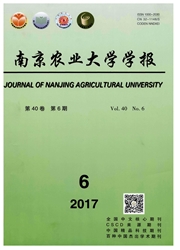

 中文摘要:
中文摘要:
[目的]本研究旨在利用微生物活化土壤中的磷素,提高植物磷素吸收效率,促进植物生长。[方法]采用蒙金娜固体平板从不同类型的土壤中分离筛选溶磷效果较好的细菌菌株,通过形态学观察、理化特性检测和16S rRNA基因序列分析对菌株进行鉴定,摇瓶试验比较研究其溶解Ca3(PO4)2及氟磷灰石的能力,并采用定性的方法检测其产生IAA及铁载体的能力,盆栽试验探索其对大豆促生的潜能。[结果]从土壤中分离获得7株溶磷细菌san5、san6、san8、DLT2、DLT3、DLT4、DK6。菌株san8和DLT4对Ca3(PO4)2、氟磷灰石的溶解效率明显优于其他菌株。各菌株分泌有机酸种类和数量差异较大,且多数菌株能分泌草酸、苹果酸、丙二酸、乙酸。菌株san5、san6、san8、DLT3和DK6产吲哚乙酸(IAA),菌株san6、DLT3和DLT4产铁载体。初步鉴定菌株san5、san8和DK6为Enterobacter sp.,菌株san6和DLT2为Pantoea sp.,菌株DLT3和DLT4为Acinetobacter sp.。盆栽试验发现,接种单一溶磷菌及多株复合菌处理均可促进大豆生长,增加土壤速效磷含量,但3株复合菌处理的溶磷促生效果显著高于单一菌株。[结论]溶磷菌能将土壤中难溶性磷酸盐转化为植物能吸收利用的可溶性磷,从而提高土壤中有效磷含量,促进植株生长发育,并且复合菌的溶磷促生效果显著高于单一菌株。
 英文摘要:
英文摘要:
[ Objectives] Phosphorus is one of the major component of organic compounds in plant. Most of the phosphorus is insoluble in soil,which cannot be absorbed by plants directly. In this study,microbial was used to activate the phosphorus in the soil and promote plant growth. Plant phosphorus uptake efficiency was also enhanced. [ Methods ] The phosphate-solubilizing bacteria strains with stronger P-solubilizing ability were isolated with Pikovskaya's plate from different soil. Strain was identified according to physiological characteristics observed, biochemical characteristics tested and 16S rRNA sequencing analysis. The dissolving Ca3 (PO4 )2 and fiuorapa- tite abilities of various strains had been studied by flask-shaking test. The ability of producing indole acetic acid(IAA) and siderophore of various strains were detected by qualitative test. The potential of phosphate-solubilizing bacteria for improving soybean growth were studied with pot experiment. [ Results] Seven strains of phosphate-solubilizing bacteria were isolated from soil, coded as san5, san6, sanS,DLT2,DLT3 ,DLT4 and DK6. The resuhs showed that the solubilizing Ca3( PO4 )2 and fluorapatite efficiency of strain san8 and DLT4 were higher than the others. The category and quantity of organic acids secreted by variou strains were significantly different ,and most strains could produce oxalic acid,malic acid,malonic acid and acetic acid. Strain san6 and DLT3 were found to be able to produce both IAA and siderophore. Strain san5,san8 and DK6 were able to produce IAA but not siderophore. Strain DLT4 was able to produce siderophore but not IAA. The strain san5, san8 and DK6 were tentatively identified as Enterobacter sp., san6 and DLT2 were identified as Pantoea sp., DLT3 and DLT4 were identified as Acinetobacter sp., respectively. The pot experiments showed that application of mixture or any one of the phosphate-solubilizing bacteria(PSB) strains increased soybean biomass, as compared with the control. But application of mixture was fou
 同期刊论文项目
同期刊论文项目
 同项目期刊论文
同项目期刊论文
 期刊信息
期刊信息
